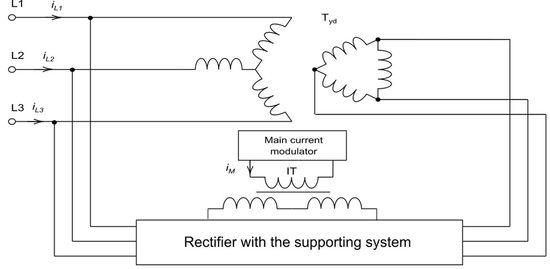Modulation Variants in DC Circuits of Power Rectifier Systems with Improved Quality of Energy Conversion—Part I
Abstract
:1. Introduction
1.1. General Concept of Modulation in the Rectifier Output Circuit
1.2. Voltage Modulator in a Rectifier System
1.3. Current Modulator in the Rectifier Circuit
- limited current regulator gain in the control circuit (necessity to ensure the stability of the closed-loop control system);
- limited bandwidth of the system (mainly due to the limitation of dynamics resulting from the need of use the output low-pass filter);
- delays in the control path of the system (e.g., by the PWM modulator),
- limited switching frequency of transistors.
- RM1800HE-34S: 1700 V/1800 A–a diode module manufactured by Mitsubishi Electric used in diode rectifiers;
- CM1800DY-34S: 1700 V/1800 IGBT–a module manufactured by Mitsubishi Electric used in transistor rectifier in 3-channel version;
- CAS120M12BM2: 1200 V/193 A–a SiC MOSFET module manufactured by Cree used in current modulator module.
2. Rectifier Circuit with Current Modulator and Additional Supporting System
2.1. The Idea of Operation and the Control Algorithm of the Supporting System
2.2. Selected Results of Simulation Tests
- based on an ideal current source;
- based on a transistor bridge with an output low-pass filter (frequency carrier signal was 10 kHz).
- for the linear CM module: from THD = 1.05% to THD = 0.08%;
- for the CM module based on the transistor H-bridge: from THD = 2.80% to THD = 2.38%.
3. Parameters of the Built Experimental Model
- supply voltage: 3 × 400 V;
- output power: 6 kW;
- output voltage (DC voltage): 180 V;
- PWM’s carrier frequency: 10 kHz.
4. Conclusions
Author Contributions
Funding
Institutional Review Board Statement
Informed Consent Statement
Data Availability Statement
Conflicts of Interest
References
- Singh, B.; Bhuvaneswari, G.; Garg, V. Harmonic mitigation using 12-pulse AC-DC converter in vector-controlled induction motor drives. IEEE Trans. Power Deliv. 2006, 21, 1483–1492. [Google Scholar] [CrossRef]
- Deshpande, A.A.; Dhend, M.H. Detection and evaluation of harmonics in 6 pulse and 12 pulse converter. In Proceedings of the 2016 International Conference on Automatic Control and Dynamic Optimization Techniques (ICACDOT), Pune, India, 9–10 September 2016; pp. 278–283. [Google Scholar] [CrossRef]
- Rozanov, Y.; Ryvkin, S.; Chaplygin, E.; Voronin, P. Fundamentals of Power Electronics: Operating Principles, Design, Formulas, and Applications; CRC Press: Boca Raton, FL, USA, 2015. [Google Scholar]
- Shklyarskiy, Y.; Hanzelka, Z.; Skamyin, A. Experimental Study of Harmonic Influence on Electrical Energy Metering. Energies 2020, 13, 5536. [Google Scholar] [CrossRef]
- McRee, B.J.; Dodson, D.A.; Wetz, D.A.; Cohen, I.J.; Heinzel, J.M.; Dong, Q. Investigation of harmonic distortion in multi-pulse rectifiers for large capacitive charging applications. In Proceedings of the IEEE International Power Modulator and High Voltage Conference (IPMHVC), San Francisco, CA, USA, 5–9 July 2016; pp. 404–408. [Google Scholar] [CrossRef]
- Kocman, S.; Kolar, V.; Trung Vo, T. Elimination of harmonics using multi-pulse rectifiers. In Proceedings of the 14th International Conference on Harmonics and Quality of Power—ICHQP 2010, Bergamo, Italy, 26–29 September 2010; pp. 1–6. [Google Scholar] [CrossRef]
- Akagi, H.; Nabae, A.; Atoh, S. Control Strategy of Active Power Filters Using Multiple Voltage-Source PWM Converters. IEEE Trans. Ind. Appl. 1977, 22, 361–368. [Google Scholar] [CrossRef]
- Supronowicz, H.; Strzelecki, R. Filtering of Harmonics in AC Power Grid; Wydawnictwo Adam Marszałek: Toruń, Poland, 1998. [Google Scholar]
- Frąckowiak, L.; Gwóźdź, M.; Porada, R. Compensation of influence of receivers on power network with application of power electronic current source. In Proceedings of the 7th European Conference on Power Electronics and Applications, EPE’97, Trondheim, Norway, 8–10 September 1997; Volume 4, pp. 886–891. [Google Scholar]
- Gwóźdź, M.; Porada, R. The Power Electronics Active Filter With Increased Quality of Output Current. In Proceedings of the 4th International Workshop CPE 2005 Compatibility in Power Electronics, CPE2005, Gdynia, Poland, 1–3 June 2005. [Google Scholar]
- Sampreeth, S.J. Implementation of Transistor Rectifiers and Comparison with Diode Rectifiers. Int. J. IT Eng. (IJITE) 2020, 8, 1–15. [Google Scholar]
- Supronowicz, H.; Strzelecki, R. Power Factor in AC Power Systems and Methods of Its Improvement; OWPW: Warszawa, Poland, 2000. [Google Scholar]
- Rolek, J. Analysis of Systems with a Parallel Connection of Diode Converters with Modulation in the DC Circuit. Ph.D. Thesis, Kielce University of Technology, Kielce, Poland, 2011. [Google Scholar]
- Rashid, H.M. Power Electronics Handbook: Devices, Circuits, and Applications; Elsevier: Amsterdam, The Netherlands, 2011. [Google Scholar]
- Gwóźdź, M.; Krystkowiak, M.; Jędryczka, C.; Gulczyński, A.; Matecki, D. Generator with modulated magnetic flux for wind turbines. Bull. Pol. Acad. Sci. Tech. Sci. 2017, 65, 469–478. [Google Scholar] [CrossRef]
- Choi, S.; Enjeti, P.; Hoag-Hee, L.; Pitel, I. A new active interphase reactor for 12-pulse rectifiers provides clean power utility interface. IEEE Trans. Ind. Appl. 1996, 32, 1304–1311. [Google Scholar] [CrossRef]
- Strzelecki, R.; Supronowicz, H. Power Factor in AC Power Supply Systems and Methods for Its Improvement; Publishing House of the Warsaw University of Technology: Warsaw, Poland, 2000. (In Polish) [Google Scholar]
- Krystkowiak, M.; Gwóźdź, M. Three-phase diode rectifier with current modulator in DC circuit based on multi-channel converter. Arch. Electr. Eng. 2017, 66. [Google Scholar] [CrossRef]
- Krystkowiak, M.; Ciepliński, Ł.; Gwóźdź, M. Methods of Current Modulation in Diode Rectifiers. In Proceedings of the 2019 Progress in Applied Electrical Engineering (PAEE), Koscielisko, Poland, 17–21 June 2019; pp. 1–5. Available online: https://ieeexplore.ieee.org/document/8788977 (accessed on 28 March 2021). [CrossRef]
- Franco, S. Design with Operational Amplifiers and Analog Integrated Circuits, 4th ed.; McGraw-Hill Education: New York, NY, USA, 2015. [Google Scholar]
- Datasheets.pdf. Available online: https://datasheetspdf.com/datasheet/PM50RSA120.html (accessed on 9 March 2021).
- Analog Devices. Available online: https://www.analog.com/media/en/technical-documentation/data-sheets/ADSP-21369.pdf (accessed on 9 March 2021).

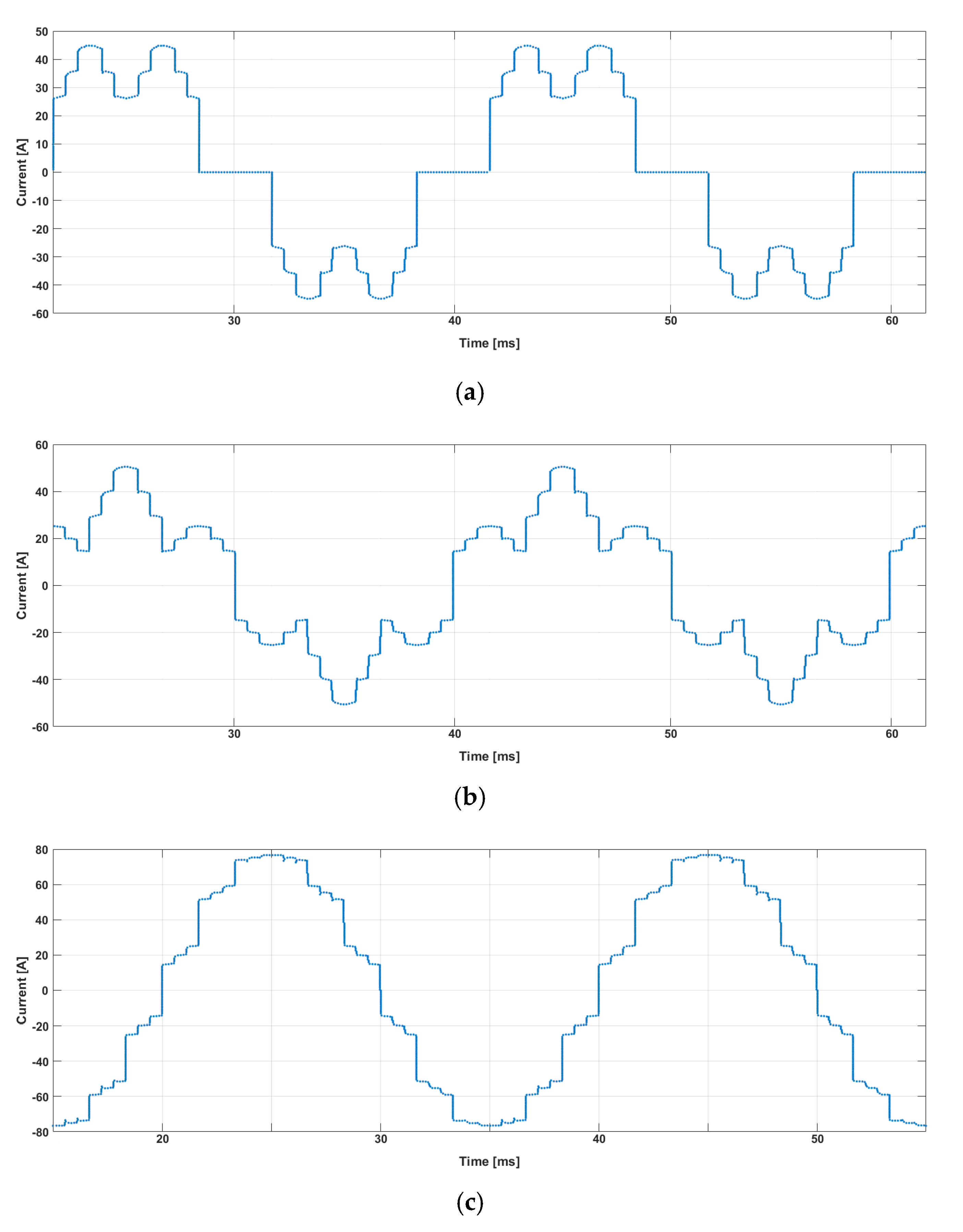

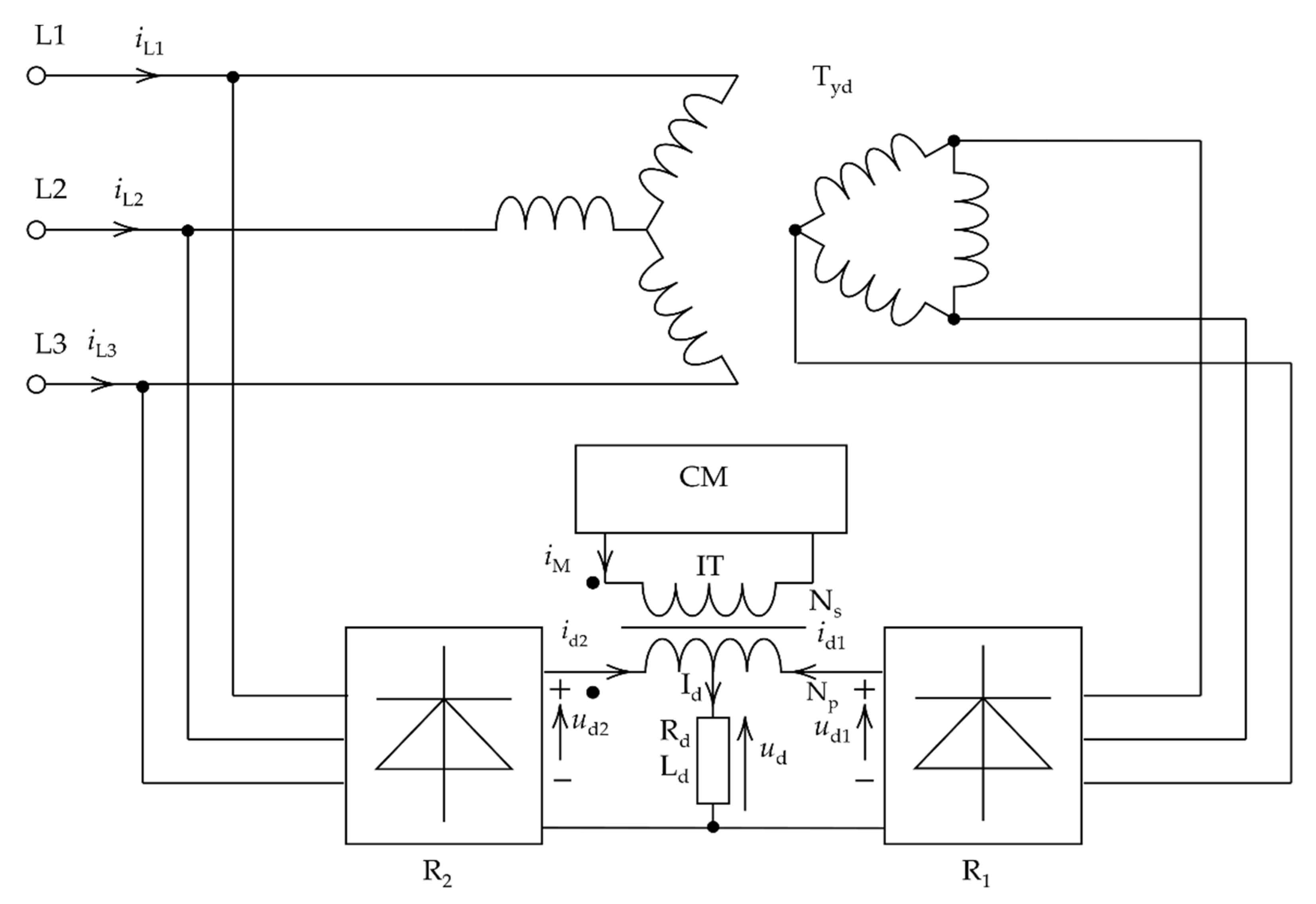

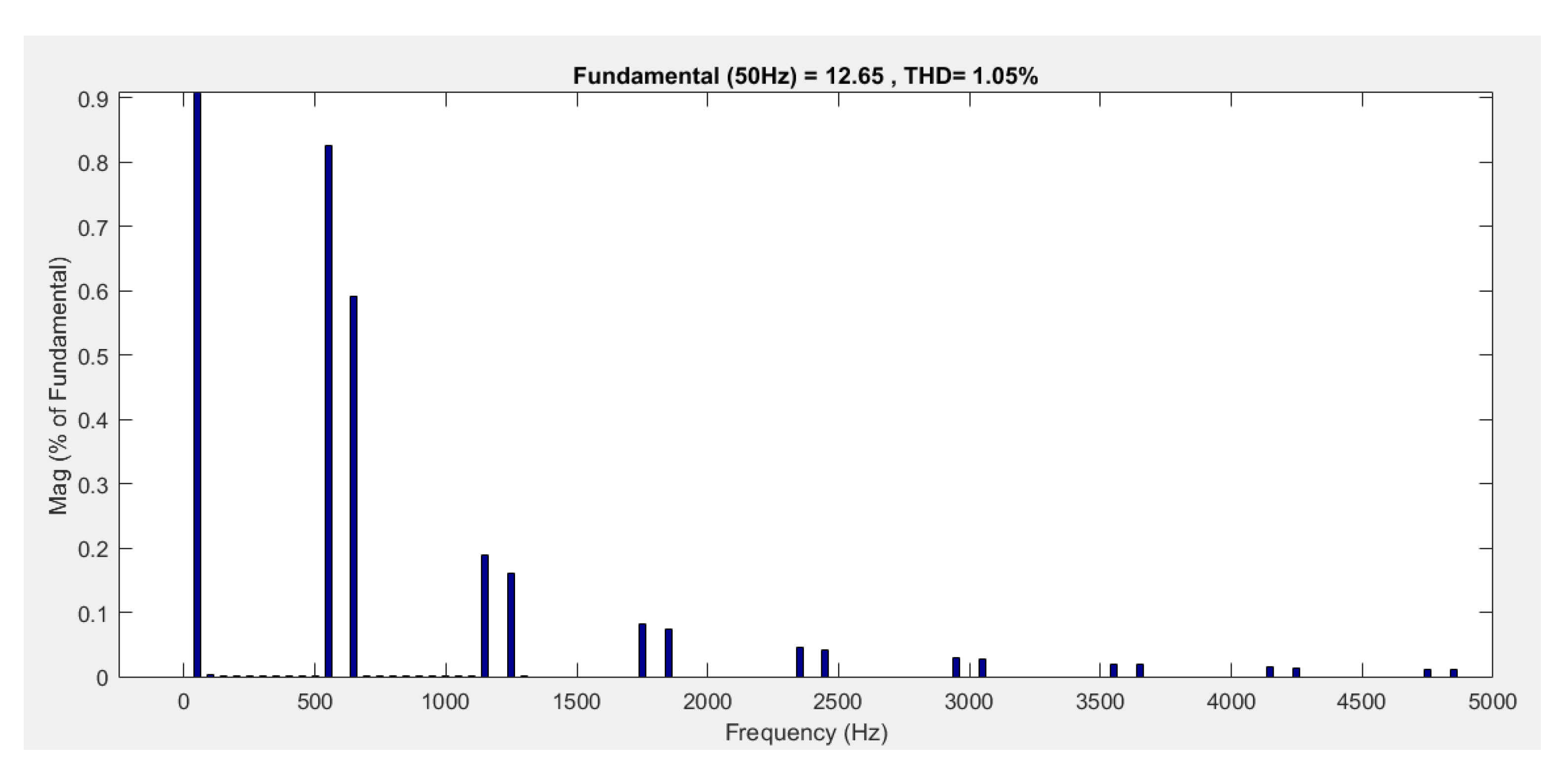
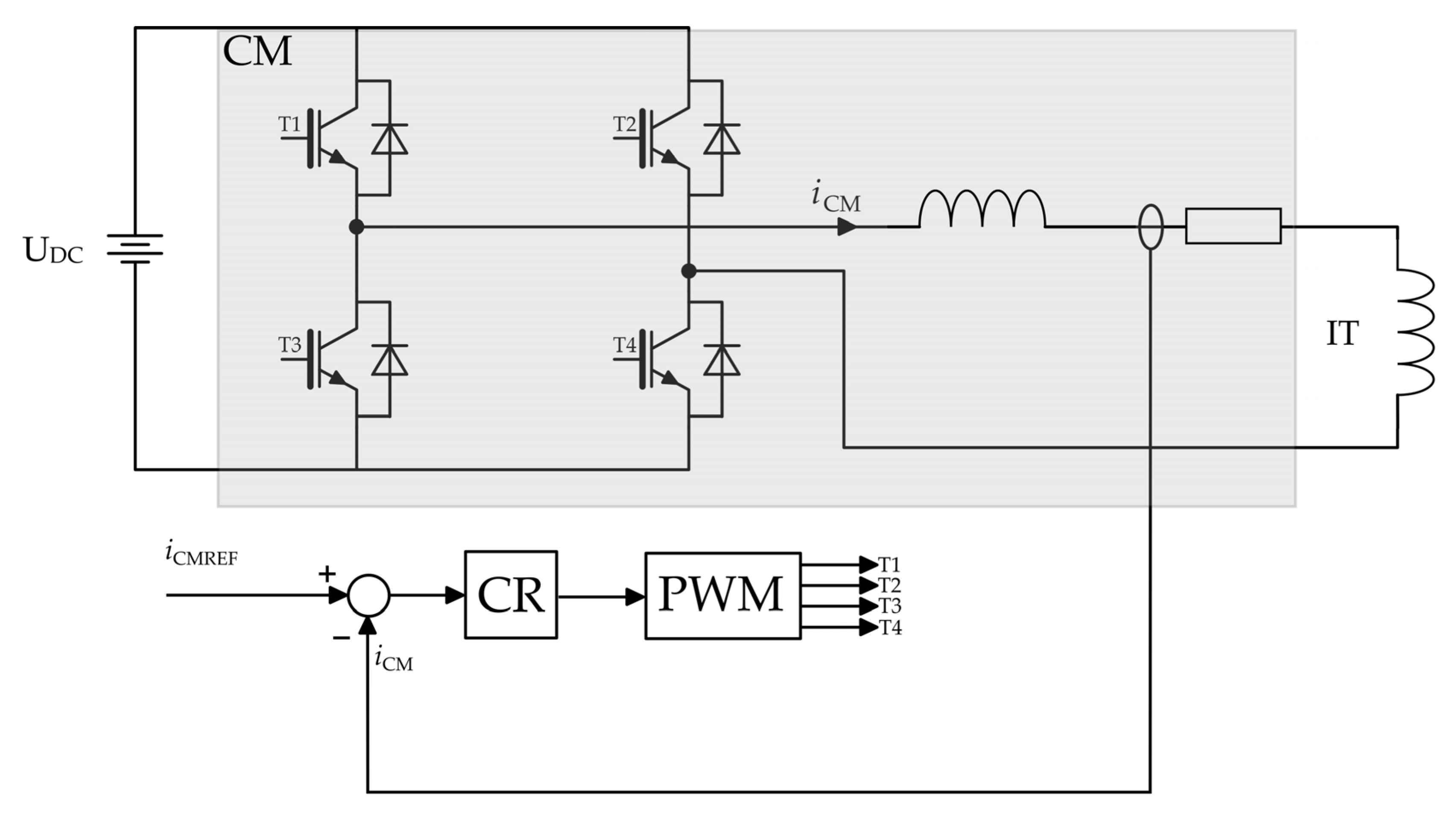
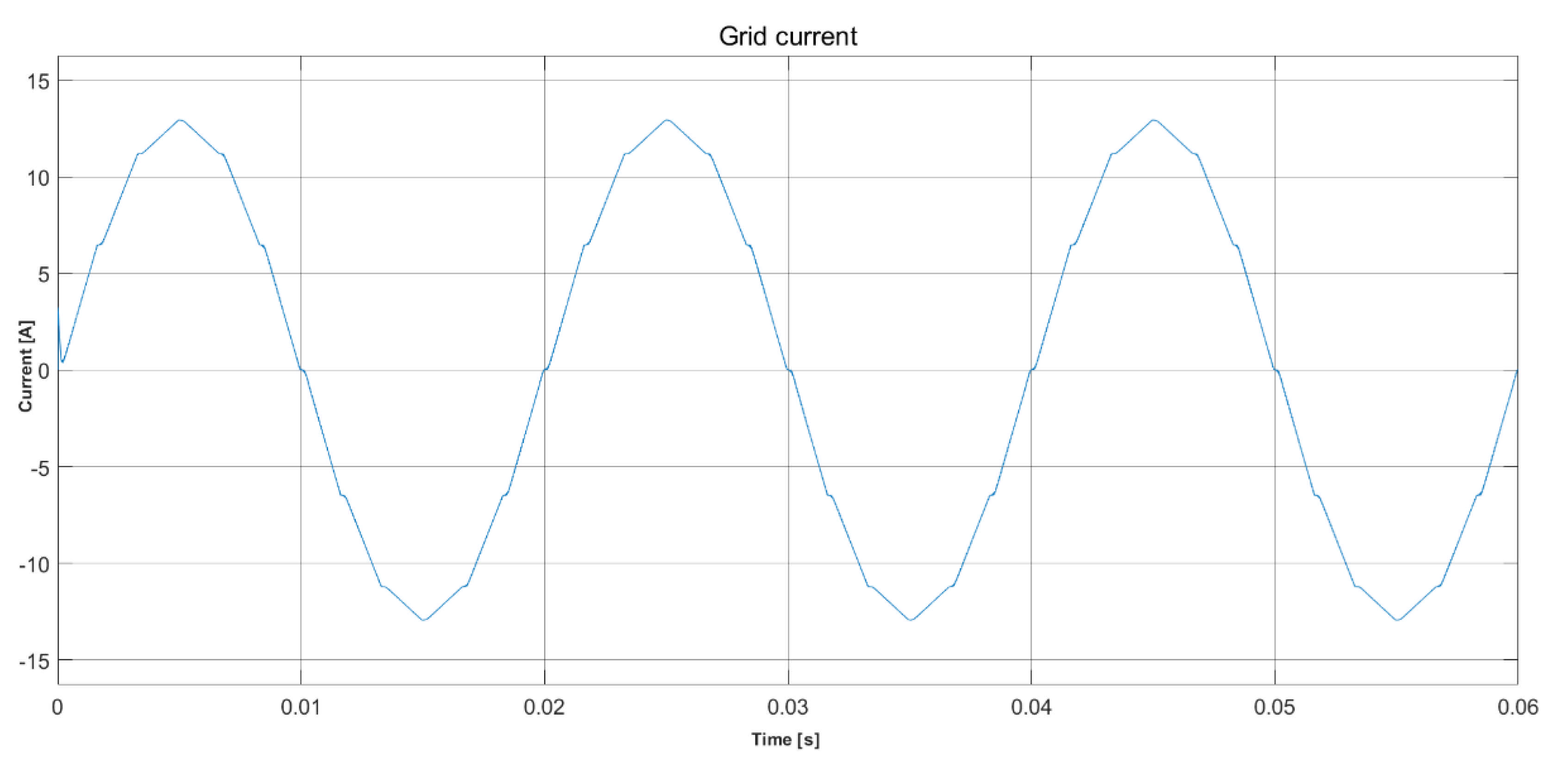
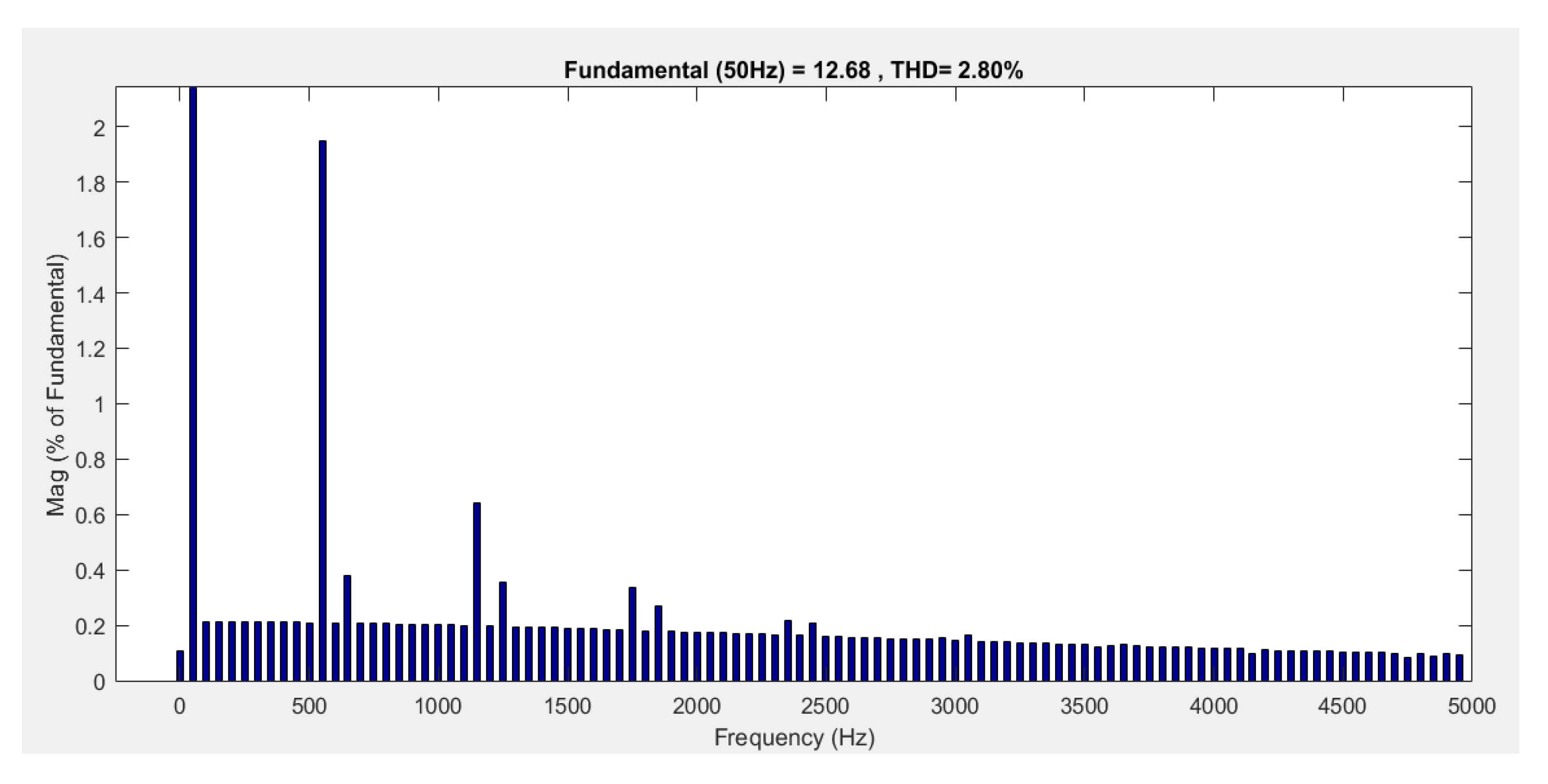

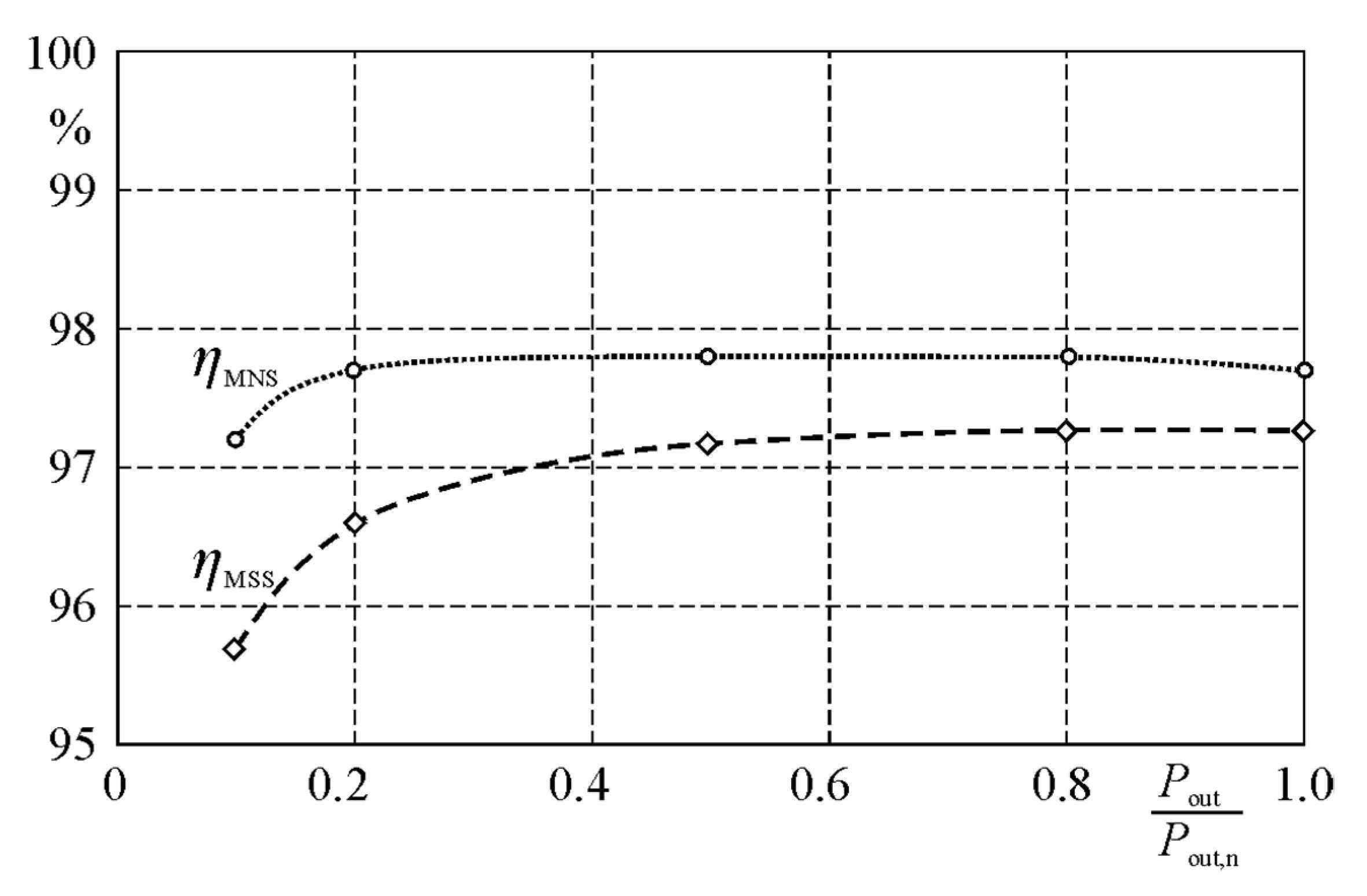


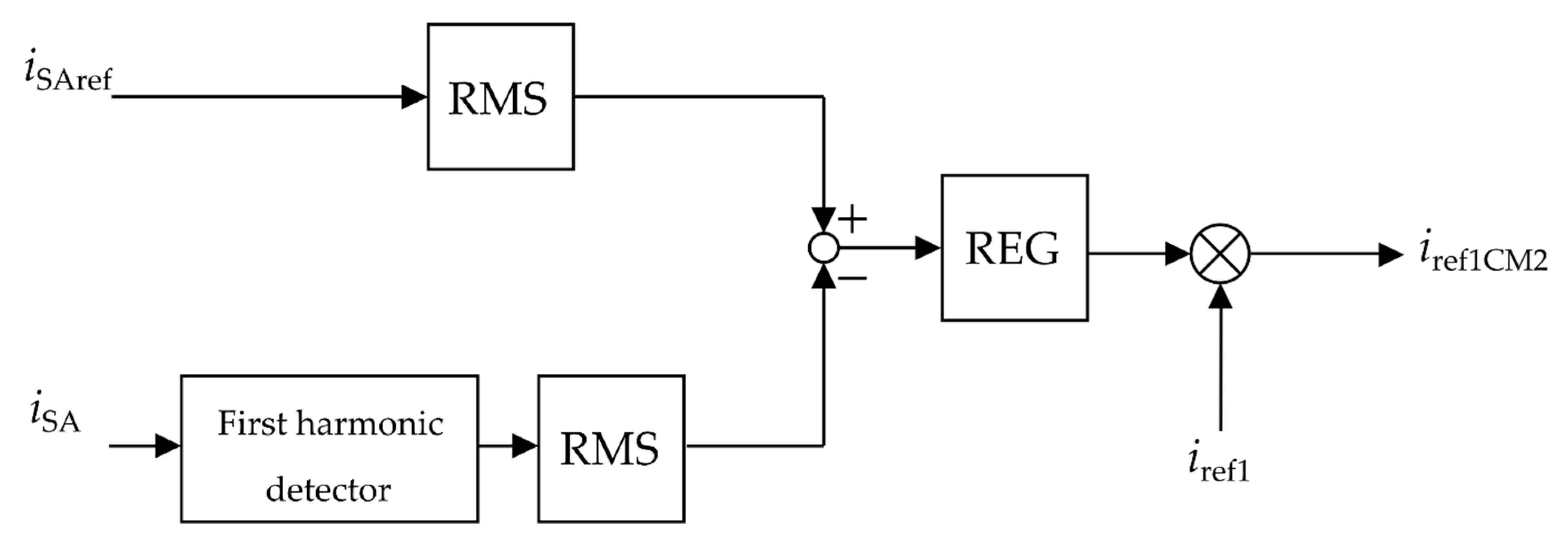



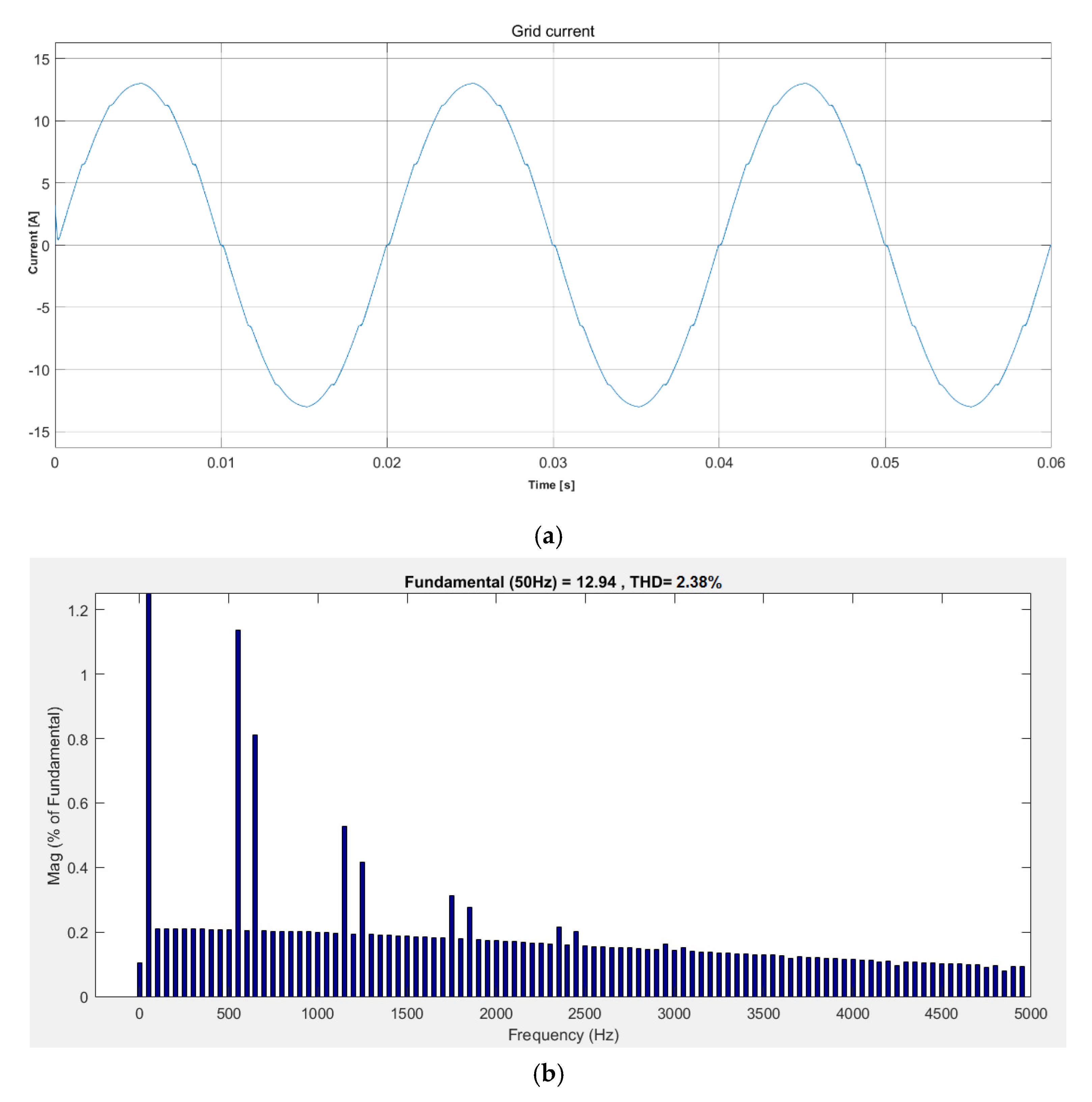
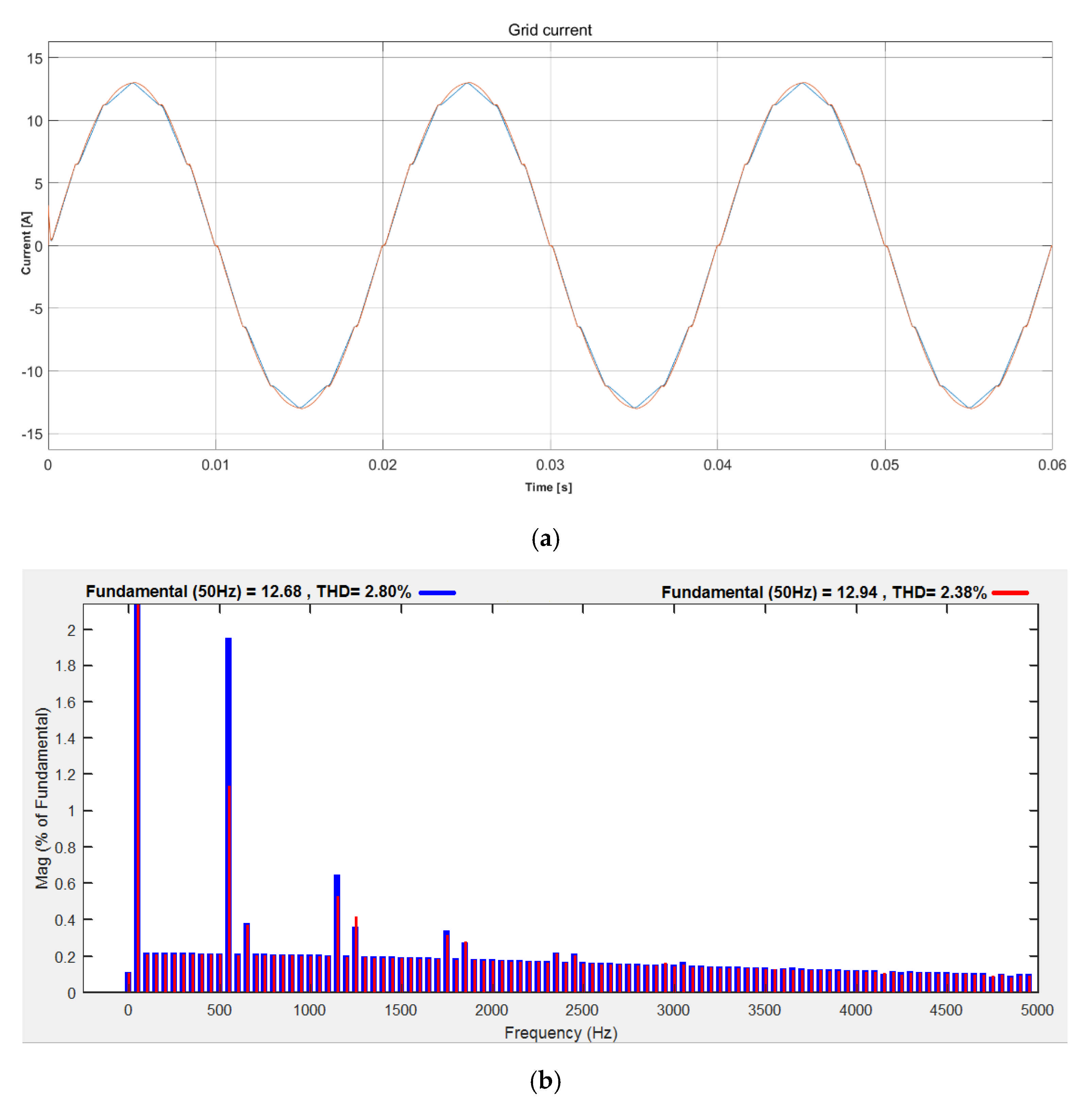
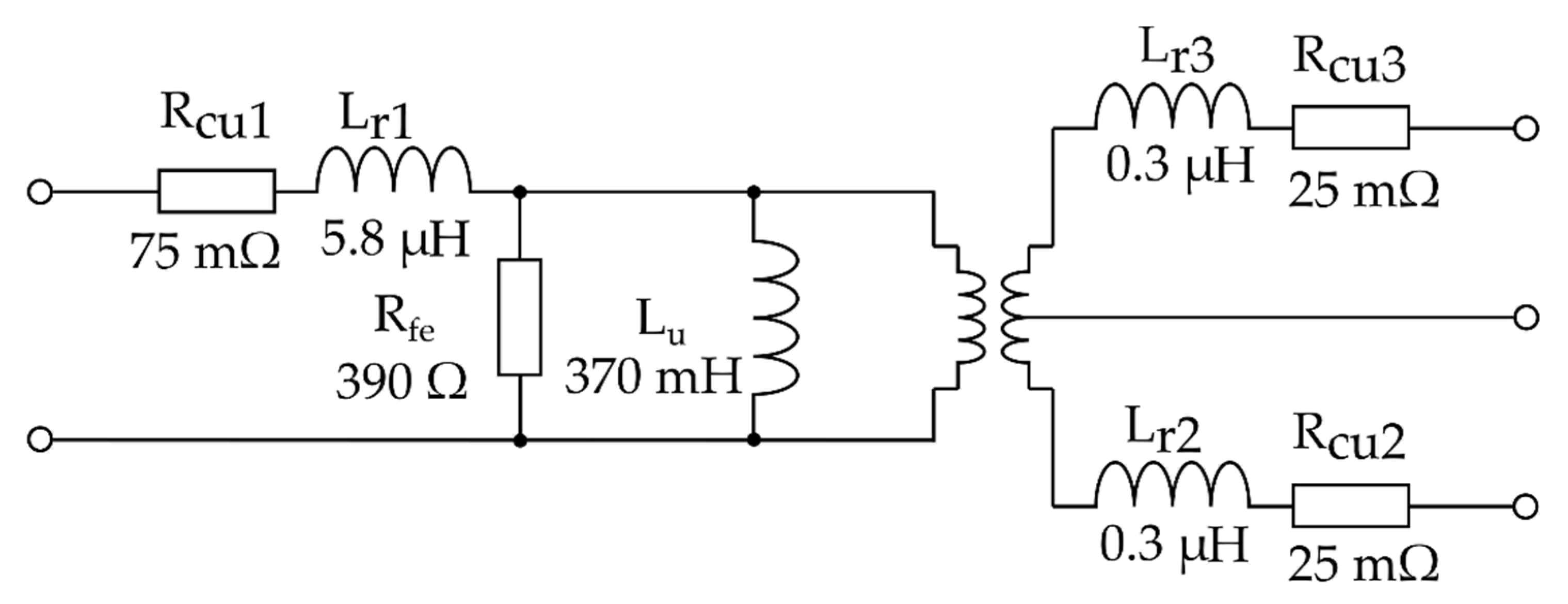
| Name of Block | Quantity | Value |
|---|---|---|
| Grid | Nominal voltage | 510 V |
| Phase’s self-inductance (star section) | 220 μH | |
| Phase’s resistance (star section) | 2.5 mΩ | |
| Phase’s self-inductance (delta section) | 450 μH | |
| Phase’s resistance (delta section) | 3.0 mΩ | |
| Diode rectifiers (R1, R2) | Rated output voltage | 720 V |
| Current modulator (CM) | Rated output power | 45 kW |
| Rated efficiency | 97.4% | |
| Output inductor | 350 μH | |
| PWM carrier frequency | 20 kHz | |
| Resistance (this respects resistance of the IT secondary side winding) | 0.3 mΩ | |
| Capacitor in DC circuit | Capacitance | 10 mF |
| Name of Block | Quantity | Value |
|---|---|---|
| Grid | Nominal voltage | 510 V |
| Phase’s self-inductance | 150 μH | |
| Phase’s resistance | 1.15 mΩ | |
| DC circuit | Rated voltage | 720 V |
| Transistor rectifier | Inductance of coil associated with inverter’s leg | 125 μH |
| Resistance of coil associated with inverter’s leg | 0.15 mΩ | |
| PWM carrier frequency | 3 kHz | |
| No of legs per inverter’s phase | 3 |
Publisher’s Note: MDPI stays neutral with regard to jurisdictional claims in published maps and institutional affiliations. |
© 2021 by the authors. Licensee MDPI, Basel, Switzerland. This article is an open access article distributed under the terms and conditions of the Creative Commons Attribution (CC BY) license (http://creativecommons.org/licenses/by/4.0/).
Share and Cite
Pajchrowski, T.; Krystkowiak, M.; Matecki, D. Modulation Variants in DC Circuits of Power Rectifier Systems with Improved Quality of Energy Conversion—Part I. Energies 2021, 14, 1876. https://doi.org/10.3390/en14071876
Pajchrowski T, Krystkowiak M, Matecki D. Modulation Variants in DC Circuits of Power Rectifier Systems with Improved Quality of Energy Conversion—Part I. Energies. 2021; 14(7):1876. https://doi.org/10.3390/en14071876
Chicago/Turabian StylePajchrowski, Tomasz, Michał Krystkowiak, and Dominik Matecki. 2021. "Modulation Variants in DC Circuits of Power Rectifier Systems with Improved Quality of Energy Conversion—Part I" Energies 14, no. 7: 1876. https://doi.org/10.3390/en14071876
APA StylePajchrowski, T., Krystkowiak, M., & Matecki, D. (2021). Modulation Variants in DC Circuits of Power Rectifier Systems with Improved Quality of Energy Conversion—Part I. Energies, 14(7), 1876. https://doi.org/10.3390/en14071876






